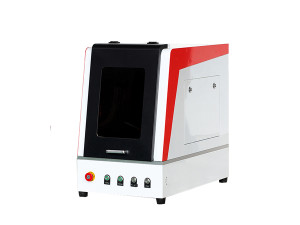What Material Fiber Laser Engraving Machine Can Do 2 – Alex
We talked what material can use fiber laser engraving machine to process in last post. and today let us see some more common laser engraving material.

8. Nickel
Plating is the most commonly use of Nickel. It can be forged or used as the base metal for some parts, but it is too soft for industrial use. People use plating to protect these parts from corrosive elements. Care must be taken in order to prevent it from becoming pierced or damaged, which would expose the underlying metallic surface.
It is our experience that lower powered, faster pulsing lasers have the best results. Anneal or polish to protect the plating. The annealed marking will be black and the polished marking is typically white. In the rare case that the entire part is comprised of nickel, all marking techniques are appropriate.
9. Plastics and polymers
Plastics and polymers are the most expansive and variable materials that are marked with lasers. There are so many different chemical compositions that you cannot categorize them easily. So we recommend test marking to ensure the best results. However, natual delrin is white and does not mark at all with any laser. Even the most powerful laser marking system will not make a mark on this material.
The most common technique in plastic and polymer marking is color changing. This type of mark uses the energy of the laser beam to alter the molecular structure of the piece, then change the color of the substrate without damaging the surface. Some plastics and polymers can be lightly etched or engraved, but consistency is always a concern.
10. Rubber
Rubber is an ideal substrate for engraving or etching because it is soft and highly absorbent. However laser marking rubber does not offer contrast. Tires and handles are a few examples of rubber marking.
So many people use fiber laser engraving machine marking on rubber engraving. The only factors to consider are the speed and depth of the marking, as each laser series offers the same exact marking type. The more powerful the laser, the faster the engraving or etching process will be.
11. Semiconductor industry
Semiconductor industry use very wide range materials . You have ceramics, printed circuit boards, epoxy resins/molds, and silicon integrated circuits to name a few. The big key when marking on semiconductor substrates is precision accuracy and depth control. Accuracy is required to ensure proper placement and readability of markings that are commonly smaller than 1mm in size and read by vision systems. Depth control limits the amount of particulate dust and thermal transfer to protect sensitive electronics or components.
12. Silver and Gold
Precious metals like silver and gold are very soft. Silver is a tricky material to mark as it oxidizes and tarnishes easily. Gold can be very easy to mark, requiring little power to get a good, contrasting anneal.
Silver and gold is one of the most common material for fiber laser engraving machine. Also we need do machine details according to your request. Because of the value of these substrates, engraving and etching are not common. Annealing allows the surface oxidation to create contrast, removing only a negligible amount of material.
13. Stainless Steel
Next to aluminum, stainless steel is the most commonly laser marking material of fiber laser engraving machine. Virtually every industry use it. There are several types of steels, each with varying carbon content, hardness, and finishes. Part geometry and size also vary greatly, but all allow for a variety of marking techniques.
Stainless steel lends itself to every laser marking technique used today. Carbon migration or annealing is rather simple and black anneals can be achieved with low or high wattage. Etching and engraving are also easy, because the steel is absorbent and is good enough at thermal transfer to help mitigate damage. Polish marking is possible, too, but it’s a rare choice because most applications require contrast.
14. Titanium
This lightweight super alloy is used heavily in medical and aerospace applications because of its strength, durability and limited mass. This industries carry heavy liability and need to ensure that the marking is safe and non-damaging. Aerospace applications require heavy fatigue testing to ensure no structural damage is incurred. Not all lasers are capable of performing such markings. For the medical industry, most titanium parts are actually placed inside of the human body permanently, or for surgical tools which will be used inside of the human body. Because of this, markings must be sterile and durable. Also fiber laser engraving machine need FDA approve to ensure that they are truly inert and safe for their intended use.
Titanium lends itself to all marking techniques but the best laser and technique depend on the application. The aerospace industry uses annealing to limit structural damage. Medical instruments are annealed, etched or engraved depending on the intended lifecycle and use of the implement.
If you want to know more about fiber laser engraving machine, pls contact me
Alex Wang:
Mobile&whatsapp: 0086 18766152065
Email: xintian104@xtlaser.com
Skype: saint512406



